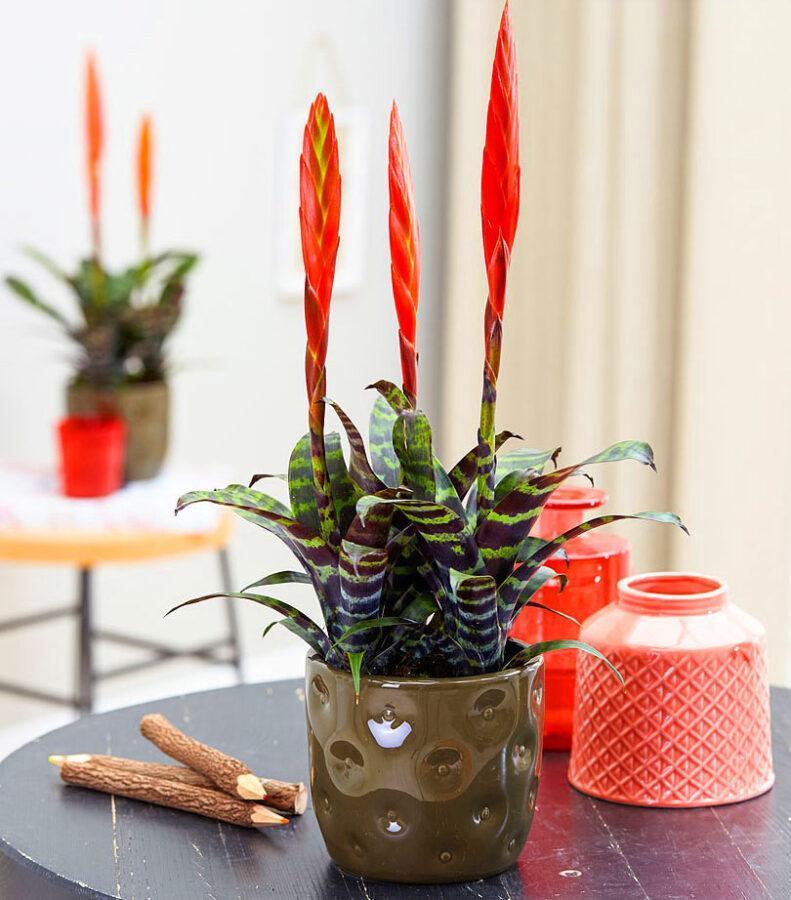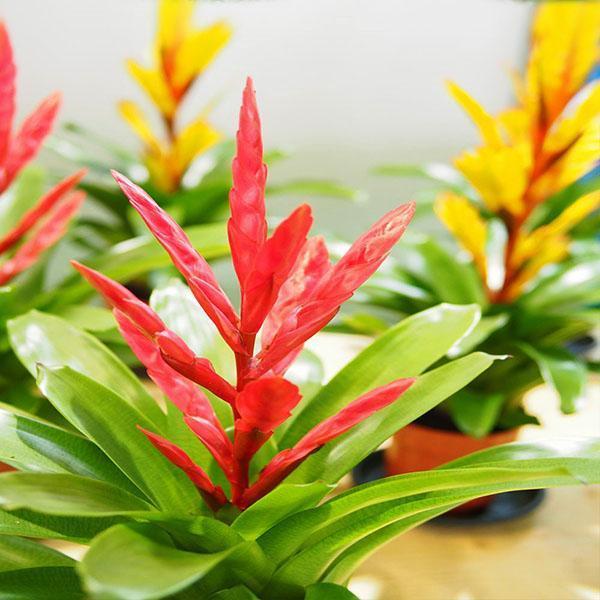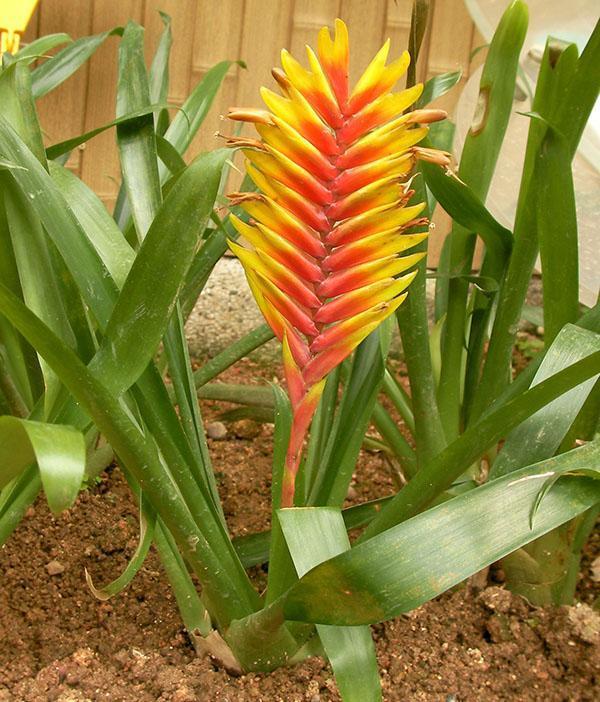Types and varieties of vriezia for growing at home
 More than two hundred varieties of these plants grow in the South American tropics, in the homeland of Vriesia. The types and varieties of Vriezia for growing at home are not so numerous, but there are more than a hundred of them. What is the attraction of the inhabitants of the tropical and subtropical zones of the southern hemisphere?
More than two hundred varieties of these plants grow in the South American tropics, in the homeland of Vriesia. The types and varieties of Vriezia for growing at home are not so numerous, but there are more than a hundred of them. What is the attraction of the inhabitants of the tropical and subtropical zones of the southern hemisphere?
Be it terrestrial or epiphytic plants, flower growers have long loved them for their decorative rosette of juicy elongated leaves and large spike-shaped or paniculate inflorescences.
Vriezii are both beautiful and unpretentious. Therefore, new varieties and hybrids are constantly being developed for indoor floriculture.
These forms, which are not found in nature, amaze with the extraordinary brightness of the bracts bordering the corollas and variegated, spotted or striped foliage. In specialized stores, such plants are most often offered under the name "Vriezia Mix". They are compact, coexist with other home flowers without problems and bloom quickly, without special processing.

Vriezia keeled (V. carinata)
 At home, this variety takes root with equal success on the branches of trees, and under their crowns, among many terrestrial plants. For flower growers around the world, keeled Vriezia is one of the most popular indoor species. The culture is easy to recognize by its relatively small rosette up to 40-50 cm in diameter, consisting of linear leaves of light green color. The surface of the leaves, like their edges, is smooth.
At home, this variety takes root with equal success on the branches of trees, and under their crowns, among many terrestrial plants. For flower growers around the world, keeled Vriezia is one of the most popular indoor species. The culture is easy to recognize by its relatively small rosette up to 40-50 cm in diameter, consisting of linear leaves of light green color. The surface of the leaves, like their edges, is smooth.
 By the beginning of flowering, a strong erect peduncle up to 30 centimeters high appears from the center of the funnel-shaped rosette. It is crowned with a flattened spike-shaped inflorescence with pink-orange bracts that do not lose their decorative effect for a long time. Hard, brightly colored leaves hide yellow corollas 4–6 cm long.
By the beginning of flowering, a strong erect peduncle up to 30 centimeters high appears from the center of the funnel-shaped rosette. It is crowned with a flattened spike-shaped inflorescence with pink-orange bracts that do not lose their decorative effect for a long time. Hard, brightly colored leaves hide yellow corollas 4–6 cm long.
Due to the small size of the flowers and the rapid wilting, some novice growers mistake the bracts for the flowers themselves.
Among the types and varieties of vriezia for indoor floriculture, this one is best suited. A compact outlet does not require much space, and flowering sometimes takes place twice a year, in the first half of summer and early winter.
Vriesea splendens
 Like the previous species, brilliant Vriezia is an inhabitant of both the lower and upper belts of the tropical rainforest. The peculiarity of the plant is a rather weak root system, which does not penetrate too deeply into the soil, but it can supply the plant with moisture obtained from the surrounding air. At home, vriezia with variegated leaves, like strokes covered with dark transverse stripes, forms a rosette up to 40 cm wide. The color of the stripes can vary from deep green to purple. Broad-lanceolate leaves are bent at the ends, and raised to the center of the rosette, forming a narrow deep funnel. An erect peduncle appears from it during flowering.
Like the previous species, brilliant Vriezia is an inhabitant of both the lower and upper belts of the tropical rainforest. The peculiarity of the plant is a rather weak root system, which does not penetrate too deeply into the soil, but it can supply the plant with moisture obtained from the surrounding air. At home, vriezia with variegated leaves, like strokes covered with dark transverse stripes, forms a rosette up to 40 cm wide. The color of the stripes can vary from deep green to purple. Broad-lanceolate leaves are bent at the ends, and raised to the center of the rosette, forming a narrow deep funnel. An erect peduncle appears from it during flowering.
Yellow flowers, 2 to 5 cm long, are reliably covered with rigid carmine-red bracts, forming a compressed, wide lanceolate ear.
 The popular variety of Vriezia brilliant Flaming Sword, as in the photo, does not have stripes on the leaves, but conquers flower growers with powerful inflorescences with scarlet bracts and fiery yellow flowers. This species is characterized by long flowering and excellent endurance.
The popular variety of Vriezia brilliant Flaming Sword, as in the photo, does not have stripes on the leaves, but conquers flower growers with powerful inflorescences with scarlet bracts and fiery yellow flowers. This species is characterized by long flowering and excellent endurance.
Vriezia royal (V. regina)
 One of the largest species among Vriese varieties for growing at home. The leaves that make up the rosette are bright green in color and can grow up to 1–1.2 meters in length. The width reaches 15 cm. In indoor culture, the royal vriezia is smaller than in nature.
One of the largest species among Vriese varieties for growing at home. The leaves that make up the rosette are bright green in color and can grow up to 1–1.2 meters in length. The width reaches 15 cm. In indoor culture, the royal vriezia is smaller than in nature.
 But here, too, the name of the flower is fully justified by the size and the original type of inflorescence. This is a complex branched panicle up to two meters high. The branches bearing flowers resemble an ear and combine 10-16 whitish-yellow flowers each. Corollas emit a light aroma, bracts are white-pink, hard at the edges.
But here, too, the name of the flower is fully justified by the size and the original type of inflorescence. This is a complex branched panicle up to two meters high. The branches bearing flowers resemble an ear and combine 10-16 whitish-yellow flowers each. Corollas emit a light aroma, bracts are white-pink, hard at the edges.
Vriezia perforated (V. fenestralis)
 Many species and varieties of Vriesia are indigenous to the moist forests of Brazil, Argentina and other parts of South America. Local conditions are excellent for heat-loving plants. Vriezia perforated in nature is found in the mountain forests of Brazil. Among the flower growers of the world, it is known as an ornamental-deciduous culture with bright leaves of a broadly linear shape with beautifully curved tips. The young foliage of this variety is noticeably lighter than the adult and is often covered with golden-green stripes and spots. The pointed tip of the leaf has a burgundy-red color, which is also noticeable on the back of the leaf blades.
Many species and varieties of Vriesia are indigenous to the moist forests of Brazil, Argentina and other parts of South America. Local conditions are excellent for heat-loving plants. Vriezia perforated in nature is found in the mountain forests of Brazil. Among the flower growers of the world, it is known as an ornamental-deciduous culture with bright leaves of a broadly linear shape with beautifully curved tips. The young foliage of this variety is noticeably lighter than the adult and is often covered with golden-green stripes and spots. The pointed tip of the leaf has a burgundy-red color, which is also noticeable on the back of the leaf blades.
A rosette of variegated vriezia leaves has a diameter of 50 to 80 cm.When the plant is preparing to bloom, a green peduncle up to half a meter high appears from the center. Light yellow bracts, strewn with brownish-purple spots, protect small yellow corollas.
Vriezia giant (V. gigantea)
 Another large variegated species with rigid broad-lanceolate leaves forming a voluminous luxurious rosette. At the edges, the leaves covered with a scattering of light green splashes deviate, becoming horizontal, in the core of the leaf plates vrieses giant or checkerboard take the form of a graceful glass.
Another large variegated species with rigid broad-lanceolate leaves forming a voluminous luxurious rosette. At the edges, the leaves covered with a scattering of light green splashes deviate, becoming horizontal, in the core of the leaf plates vrieses giant or checkerboard take the form of a graceful glass.
 Unlike the royal or keeled vriezia, the flowering of this variety is not so impressive. The branched paniculate inflorescence is very rare, and the flowers in small green stipules have a pale yellow tint.
Unlike the royal or keeled vriezia, the flowering of this variety is not so impressive. The branched paniculate inflorescence is very rare, and the flowers in small green stipules have a pale yellow tint.
Vriezia Sanders (V. saundersii)
 In nature, Vriezia Sanders prefers to live on rocky slopes, where more often than other species it lacks moisture. Therefore, the leaves of this plant are quite dense and tough. The width of the rosette reaches 50-60 cm, and its height is 40 cm. Smooth leathery leaf plates have a gray-green color, sometimes with a purple glow, which becomes most noticeable and bright on the back side.
In nature, Vriezia Sanders prefers to live on rocky slopes, where more often than other species it lacks moisture. Therefore, the leaves of this plant are quite dense and tough. The width of the rosette reaches 50-60 cm, and its height is 40 cm. Smooth leathery leaf plates have a gray-green color, sometimes with a purple glow, which becomes most noticeable and bright on the back side.
 A straight or drooping peduncle bears a highly branched inflorescence with spike-shaped brushes. Yellow flowers up to 4 cm long are covered with stipules of the same shade.
A straight or drooping peduncle bears a highly branched inflorescence with spike-shaped brushes. Yellow flowers up to 4 cm long are covered with stipules of the same shade.
Vriezia hieroglyphic (V. Hieroglyphica)
 This variegated vriezia is one of the brightest species suitable for indoor cultivation. Light green leaves from the base to the pointed tips are covered with patterned transverse stripes of a darker shade. The leaf plates themselves are assembled into a dense funnel-shaped rosette with a diameter of up to 40 cm.
This variegated vriezia is one of the brightest species suitable for indoor cultivation. Light green leaves from the base to the pointed tips are covered with patterned transverse stripes of a darker shade. The leaf plates themselves are assembled into a dense funnel-shaped rosette with a diameter of up to 40 cm.
 The inflorescence of Vriezia hieroglyphic is a branched panicle about 50 cm high. Slightly drooping branches bear yellow flowers. Thanks to breeders, hybrids of this type of vriezia have appeared at the disposal of florists today, pleasing with more spectacular flowering, for example, bracts not greenish, but pink-orange or yellow.
The inflorescence of Vriezia hieroglyphic is a branched panicle about 50 cm high. Slightly drooping branches bear yellow flowers. Thanks to breeders, hybrids of this type of vriezia have appeared at the disposal of florists today, pleasing with more spectacular flowering, for example, bracts not greenish, but pink-orange or yellow.